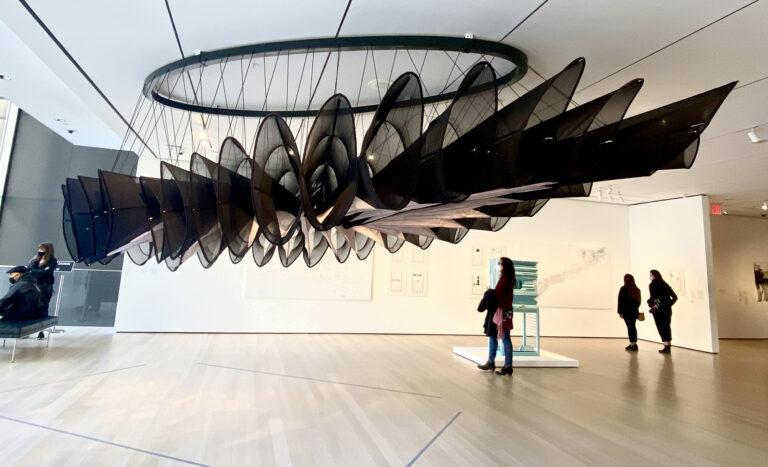'Demo'
← 'Demo'
June 13 to 15Demo / Petal Antenna: An Knitted Textile EMF Sensor

- Abstract: This demo presents a single knitted textile cone (i.e. a petal) of the electronic sculpture-installation work by the authors entitled Flower Antenna, exhibited in Spring 2021 at the Museum of Modern Art, New York City (MOMA). The work operates as a large receiving antenna that senses electromagnetic fields in the gallery space. Using a logarithmic amplifier circuit, electromagnetic fields are converted to sonic expressions heard in the installation space, revealing the site-specific electromagnetic atmosphere of the gallery. The demo presents textile antenna samples and EMF-sensing circuits designed throughout the development of the work.
- Biography: Erin Lewis is a Ph.D. candidate in Textile Interaction Design at The Swedish School of Textiles, University of Borås. Her research explores the interactive space between structural textile design and electromagnetic fields. She employs artistic methods and designs custom electronic tools to explore the aesthetic and expressional possibilities of the phenomena in relation to textile designs. She has recently published her licentiate thesis entitled ‘Radiant Textiles: A Framework for Designing with Electromagnetic Phenomena’. Prior to her studies in Sweden, Erin was a researcher and instructor of wearable technologies in the Faculty of Design at OCAD University in Toronto, Canada. She previously held the position of Education Manager at Canada’s leading new media art gallery, Inter/Access, in Toronto.
Felecia Davis’ work in computational textiles questions how we live and she re-imagines how we might use textiles in our daily lives and in architecture. Davis is interested in developing computational methods and design in relation to specific bodies in specific places engaging specific social, cultural and political constructions. Davis is an Associate Professor at the Stuckeman Center for Design Computing in the School of Architecture at Pennsylvania State University and is the director of SOFTLAB@PSU. She completed her PhD in Design Computation at MIT. Davis’ work in architecture connects art, science, engineering and design and was featured by PBS in the Women in Science Profiles series. Davis’ work was part of the Museum of Modern Art’s exhibition Reconstruction: Blackness and Architecture in America. She is a founding member of the Black Reconstruction Collective a not-for-profit group of Black architects, scholars and artists supporting design work about the Black diaspora.
Farzaneh Oghazian started her Ph.D. in 2018 as part of the Design Computing cluster at Penn State University. Her research focuses on developing computational methods to enhance the implementation of knits as a material for architectural design. Behavior, form-finding process and predicting the shape of knitted textiles are central to her research. She uses machine learning methods for the reverse form-finding process in architectural knitted textile structures. Farzaneh is currently a research assistant in the SOFTLAB@PSU at the Stuckeman Center for Design Computing in the School of Architecture, doing research on large-scale application of the knitted textiles under supervision of Dr. Felecia Davis.
Berfin Evrim is a current Ph.D. in Environmental Design student at the University of Calgary. She graduated with Integrated Bachelor of Architecture and Master of Science in Architecture (Design Computing) from Pennsylvania State University. Her research focuses on digital fabrication, computational design, and lightweight smart materials. Currently, she studies the combination of 3D printing and knitting fabrication methods to design adaptive building skins. She utilizes simulation techniques to understand the structural behavior and environmental performance of the knitted vertical element.
Venue
- CCCB
Montalegre, 5 - 08001 Barcelona
⟵ Return to 'Demo'





